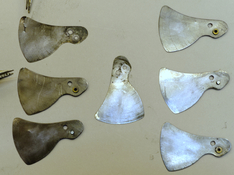Dan Daniel
Subscriber
I wonder what experiences people have had with high heat affecting mechanical camera operation. I recently got back in a camera where someone said that it worked fine in 'regular' temperatures- 70-80F/20-25C. But in recent shooting above 90F/33C, he had many blank frames as if the shutter didn't fire.
This is a Kodak Medalist where the shutter release mechanism and the wind release mechanism are separate, and both make a distinct click. So it is recurring problem with unadjusted Medalists to get blank frames as people hear a click but it was only the wind releasing, not the shutter.
When I got the camera in, everything was fine. Shutter release and wind release synced, shutter fired smoothly, etc. I was wondering, then remembered the heat issue. So I put the camera in a box and sat it out in my natural outdoor sauna in the low 90s. After an hour, I noticed the shutter jittering during cocking and exposing one tip that was torn. And then it didn't fire a few times. I didn't experience the wind and shutter release going out of sync.
Attached is a photo of the shutter blades. As you can see, one rather torn tip. And one well-dented tip. I assume that this is the cause of the problems. Not sure if the blades simply failed over time, if I nicked them in re-assembly, or what. And then they ate each other up more in use?
Anyway, the real question is what have people noticed in equipment failures or changed operation in higher heats? Any equipment destruction? Or do you think that heat simply makes more obvious some existing conditions? And any approaches to preparing a camera for temperatures in the 90/33 plus range? Less lube. different lubes? I know that there are low temp greases out there.
Thanks.
This is a Kodak Medalist where the shutter release mechanism and the wind release mechanism are separate, and both make a distinct click. So it is recurring problem with unadjusted Medalists to get blank frames as people hear a click but it was only the wind releasing, not the shutter.
When I got the camera in, everything was fine. Shutter release and wind release synced, shutter fired smoothly, etc. I was wondering, then remembered the heat issue. So I put the camera in a box and sat it out in my natural outdoor sauna in the low 90s. After an hour, I noticed the shutter jittering during cocking and exposing one tip that was torn. And then it didn't fire a few times. I didn't experience the wind and shutter release going out of sync.
Attached is a photo of the shutter blades. As you can see, one rather torn tip. And one well-dented tip. I assume that this is the cause of the problems. Not sure if the blades simply failed over time, if I nicked them in re-assembly, or what. And then they ate each other up more in use?
Anyway, the real question is what have people noticed in equipment failures or changed operation in higher heats? Any equipment destruction? Or do you think that heat simply makes more obvious some existing conditions? And any approaches to preparing a camera for temperatures in the 90/33 plus range? Less lube. different lubes? I know that there are low temp greases out there.
Thanks.





